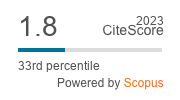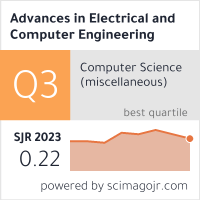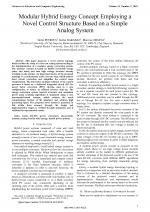| 2/2016 - 1 | View TOC | « Previous Article | Next Article » |
Modular Hybrid Energy Concept Employing a Novel Control Structure Based on a Simple Analog SystemPETREUS, D. |
| View the paper record and citations in |
| Click to see author's profile in |
| Download PDF |
Author keywords
DC-DC power converters, photovoltaic systems, analog circuits, wind energy, hybrid power systems
References keywords
power(24), energy(11), system(7), wind(6), maximum(6), grid(6), point(5), photovoltaic(5), control(5), tracking(4)
Blue keywords are present in both the references section and the paper title.
About this article
Date of Publication: 2016-05-31
Volume 16, Issue 2, Year 2016, On page(s): 3 - 10
ISSN: 1582-7445, e-ISSN: 1844-7600
Digital Object Identifier: 10.4316/AECE.2016.02001
Web of Science Accession Number: 000376996100001
SCOPUS ID: 84974829731
Abstract
This paper proposes a novel control topology which enables the setup of a low cost analog system leading to the implementation of a modular energy conversion system. The modular concept is based on hybrid renewable energy (solar and wind) and uses high voltage inverters already available on the market. An important feature of the proposed topology is a permanently active current loop, which assures short circuit protection and simplifies the control loops compensation. The innovative analogue solution of the control structure is based on a dedicated integrated circuit (IC) for power factor correction (PFC) circuits, used in a new configuration, to assure an efficient inverter start-up. The energy conversion system (control structure and maximum power point tracking algorithm) is simulated using a new macromodel-based concept, which reduces the usual computational burden of the simulator and achieves high processing speed. The proposed novel system is presented in this article from concept, through the design and implementation stages, is verified through simulation and is validated by experimental results. |
| References | | | Cited By «-- Click to see who has cited this paper |
| [1] P. Shamsi and B. Fahimi, "Stability assessment of a DC distribution network in a hybrid micro-grid application," IEEE Trans. on Smart Grid, vol. 5(5), pp. 2527-2534, 2014. [CrossRef] [Web of Science Times Cited 48] [SCOPUS Times Cited 65] [2] W. Li, J. Xiao, Y. Zhao, and X. He, "PWM plus phase angle shift (PPAS) control scheme for combined multiport DC/DC converters," IEEE Trans. Power Electron, vol. 27, no. 3, March 2012. [CrossRef] [Web of Science Times Cited 99] [SCOPUS Times Cited 128] [3] C. Zhao , S. D. Round, and J. W. Kolar, "An isolated three-port bidirectional DC-DC converter with decoupled power flow management," IEEE Trans. Power Electron., vol 23, no. 5, pp. 2443-2453, 2008. [CrossRef] [Web of Science Times Cited 542] [SCOPUS Times Cited 726] [4] Y. M. Chen, Y. C. Liu, S. C. Hung and C. S. Cheng, "Multi-input inverter for grid-connected hybrid PV/wind power system," IEEE Trans. Power Electron. vol.22, no. 3. pp. 1070-1077, May 2007. [CrossRef] [Web of Science Times Cited 207] [SCOPUS Times Cited 374] [5] J. Hui, A. Bakhshai, and P. K. Jain, "A hybrid wind-solar energy system: a new rectifier stage topology," APEC, 2010, pp. 155-161. [6] S. Daraban, D. Petreus, and C. Orian, "Control topology for high efficiency small scale wind energy conversion systems," in OPTIM, May 2014, pp. 1070-1077. [CrossRef] [SCOPUS Times Cited 3] [7] S. G. Malla, and C. N. Bhende, "Voltage control of stand-alone wind and solar energy system," Electrical Power and Energy Systems vol. 56, pp. 361-373, 2014. [CrossRef] [Web of Science Times Cited 68] [SCOPUS Times Cited 118] [8] Z. Wang, Z. Zou, and Y. Zheng, "Design and control of a photovoltaic energy and SMES hybrid system with current source grid inverter," IEEE Trans. Appl. Supercond. vol. 23, no. 3, pp. 1051-1055, 2013. [CrossRef] [Web of Science Times Cited 25] [SCOPUS Times Cited 47] [9] S. Daraban, D. Petreus, and C. Morel, "A novel MPPT (maximum power point tracking) algorithm based on a modified genetic algorithm specialized on tracking the global maximum power point in photovoltaic systems affected by partial shading," Energy,vol.74, pp. 374-388, 2014. [CrossRef] [Web of Science Times Cited 215] [SCOPUS Times Cited 257] [10] B. Somaiah and V. Agarwal, "Recursive Estimation-Based Maximum Power Extraction Technique for a Fuel Cell Power Source Used in Vehicular Applications," IEEE Trans. on Power Electron., vol 28, no. 10, pp. 4636-4643, Oct.2013. [CrossRef] [Web of Science Times Cited 20] [SCOPUS Times Cited 27] [11] J. Chen, J. Chen and C. Gong, "Constant-Bandwidth Maximum Power Point Tracking Strategy for Variable-Speed Wind Turbines and Its Design Details," IEEE Trans. Power Electron., vol. 60, no. 11, pp. 5050- 5058, Nov. 2013. [CrossRef] [Web of Science Times Cited 46] [SCOPUS Times Cited 58] [12] Steca Elektronik GmbH - "Steca PV grid Connected". [13] S. M. MacAlpine, R. W. Erickson, and M.J. Brandemuehl, "Characterization of power optimizer potential to increase energy capture in photovoltaic system operating under nonuniform conditions,"IEEE Trans. Power Electrons.,vol.28, no.6, pp.2936-2945, June 2013. [CrossRef] [Web of Science Times Cited 134] [SCOPUS Times Cited 151] [14] K. C. Tseng, C. C. Huang, and W.Y. Shih, "A high step-up converter with a voltage multiplier module for a photovoltaic system," IEEE Trans. Power Electron., vol. 28, no. 6, pp. 3047-3057, June 2013. [CrossRef] [Web of Science Times Cited 216] [SCOPUS Times Cited 264] [15] M. Balato, and M. Vitelli, "Optimization of distributed maximum power point tracking PV application: the scan of the power vs. voltage input characteristic of the inverter," Electrical Power and Energy Systems, vol. 60, pp. 334-346, April 2014. [CrossRef] [Web of Science Times Cited 18] [SCOPUS Times Cited 22] [16] P. S. Shenoy, K. A. Kim, B. B. Johnson, and P.T. Krein, "Differential power processing for increased energy production and reliability of photovoltaic system," IEEE Trans. Power Electrons., vol. 28, no.6, pp. 2968-2979, June 2013. [CrossRef] [Web of Science Times Cited 337] [SCOPUS Times Cited 397] [17] H. Hu, S. Harb, N. H. Kutkut, Z. J. Shen, and I. Batarseh, "A single-stage microinverter without using electrolytic capacitors," IEEE Trans. Power Electron., vol. 28, no. 6, pp. 2677-2687, June 2013. [CrossRef] [Web of Science Times Cited 174] [SCOPUS Times Cited 212] [18] D. Petreus, T. Patarau, S. Daraban, C. Morel, and B. Morley, "A novel maximum power point tracker based on analog and digital control loops," Solar Energy, vol. 85, no. 3, pp. 588-600, March 2011. [CrossRef] [Web of Science Times Cited 29] [SCOPUS Times Cited 35] [19] K. Anderson, J. Du, A. Narayan and A. El Gamal, "GridSpice: A distributed simulation platform for the Smart Grid," Trans. Ind. Informat., vol. 10, no. 4, pp. 2354-2363, June 2014. [CrossRef] [Web of Science Times Cited 53] [SCOPUS Times Cited 68] [20] P. Gavriluta, S. Spataru, I. Mosincat, C. Citro, I. Candela, P. Rodriguez, "Complete methodology on generating realistic wind speed profiles based on measurements," Renewable Energy & Power Quality Journal, vol. 10, pp. 828-833, 2012. Web of Science® Citations for all references: 2,231 TCR SCOPUS® Citations for all references: 2,952 TCR Web of Science® Average Citations per reference: 106 ACR SCOPUS® Average Citations per reference: 141 ACR TCR = Total Citations for References / ACR = Average Citations per Reference We introduced in 2010 - for the first time in scientific publishing, the term "References Weight", as a quantitative indication of the quality ... Read more Citations for references updated on 2024-07-19 11:44 in 115 seconds. Note1: Web of Science® is a registered trademark of Clarivate Analytics. Note2: SCOPUS® is a registered trademark of Elsevier B.V. Disclaimer: All queries to the respective databases were made by using the DOI record of every reference (where available). Due to technical problems beyond our control, the information is not always accurate. Please use the CrossRef link to visit the respective publisher site. |
Faculty of Electrical Engineering and Computer Science
Stefan cel Mare University of Suceava, Romania
All rights reserved: Advances in Electrical and Computer Engineering is a registered trademark of the Stefan cel Mare University of Suceava. No part of this publication may be reproduced, stored in a retrieval system, photocopied, recorded or archived, without the written permission from the Editor. When authors submit their papers for publication, they agree that the copyright for their article be transferred to the Faculty of Electrical Engineering and Computer Science, Stefan cel Mare University of Suceava, Romania, if and only if the articles are accepted for publication. The copyright covers the exclusive rights to reproduce and distribute the article, including reprints and translations.
Permission for other use: The copyright owner's consent does not extend to copying for general distribution, for promotion, for creating new works, or for resale. Specific written permission must be obtained from the Editor for such copying. Direct linking to files hosted on this website is strictly prohibited.
Disclaimer: Whilst every effort is made by the publishers and editorial board to see that no inaccurate or misleading data, opinions or statements appear in this journal, they wish to make it clear that all information and opinions formulated in the articles, as well as linguistic accuracy, are the sole responsibility of the author.





